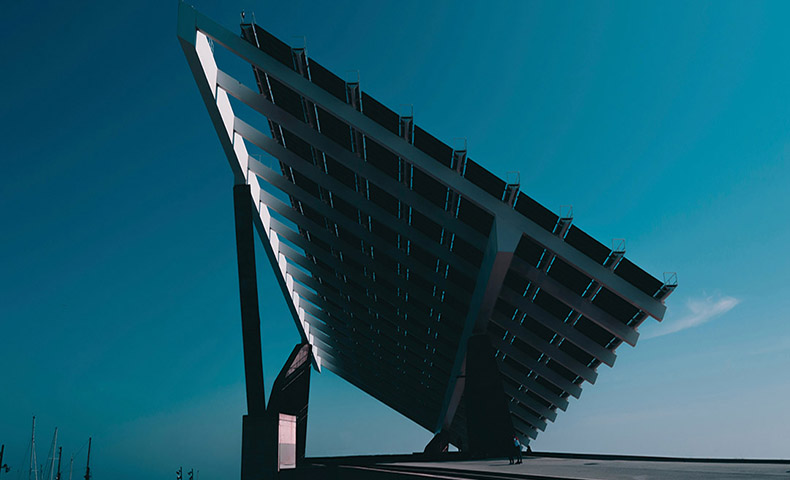
Environmentalists have been mystified by the disappearance of large numbers of bees in various locations around the world. In response to the population decline of pollinating insects, such as wild bees and monarch butterflies, researchers at the U.S. Department of Energy’s (DOE) Argonne National Laboratory are searching for ways to use “pollinator-friendly solar power.”
By researching solar energy facilities with pollinator habitats on site, scientists hope to rehabilitate pollinator populations that play a crucial role in the national and global agricultural industries. Loss of such species could destroy crop production and make food costs prohibitive at a time when starvation is killing thousands.
Despite their diminutive size, insects are mostly responsible for pollinating nearly 75 percent of all crops worldwide consumed by humans in their daily diet. As man-made environmental stressors – including pesticides and land development – have grown, insect pollinators have lost habitats and species have declined significantly.
However, a team of Argonne researchers has been testing the potential benefits of establishing pollinator habitat at utility-scale solar energy (USSE) facilities to conserve pollinators and restore the ecosystem they help make possible. Analyzing over 2,800 existing and planned USSE facilities in the contiguous United States, researchers in Argonne’s Environmental Science (EVS) division have discovered that the area around solar panels could provide an ideal location for the plants that attract pollinators. Why? Because solar doesn't cause pollution!
To learn about the advantages and disadvantages of solar, see our blog
Often filled with gravel or turf grass, this land otherwise goes unused. Research has shown that in some locations these grounds offer an ideal place to establish native plant species, such as prairie grass or wildflowers, which are prevalent pollinator habitats, in hopes of encouraging regular and sustainable population growth.
Helping to conserve declining pollinator populations, EVS researchers Lee Walston, Heidi Hartmann, Shruti Khadka Mishra, and Ihor Hlohowskyj, along with National Renewable Energy Laboratory researchers James McCall and Jordan Macknick believe that growing pollinator habitat around solar sites will also help improve the sustainability of solar energy development in agricultural regions. By increasing the ability of pollinators to pollinate adjacent agricultural fields, solar-sited pollinator habitat may increase farmer’s crop yields and make solar farms a more welcome neighbor to agricultural farms.
The researchers analyzed whether solar-sited pollinator habitat could benefit agriculture in a recent study published in Environmental Science & Technology. The study found over 3,500 square kilometers of agricultural land near existing and planned USSE facilities that could benefit. Walston believes this method of rehabilitation could help the declining pollinator population recover with consequent side effects.
“Solar-sited pollinator habitat can help optimize the land-use efficiency of solar energy developments, while not compromising solar panel efficiency,” he said.
“We’re also looking into whether the high upfront costs for seed mixes and establishing the pollinator habitats will be offset by lower facility maintenance costs,” added Hartmann.
Walston and Hartmann looked at three example crop types to measure the agricultural benefits of increased pollinator habitat. These crops – soybeans, almonds, and cranberries – depend on insect pollinators for their annual crop production. If all existing and planned solar facilities near these crops included pollinator habitat and increased yield by just one percent, crop values could raise $1.75 million, $4 million and $233,000 for soybeans, almonds, and cranberries, respectively. Walston and Hartmann’s research is the first to substantively support the agricultural benefits of adding pollinator habitat at solar facilities. Next, said Hartmann, the team will begin fieldwork that measures the type and numbers of native pollinators in areas surrounding USSE facilities. This study provides yet more opportunities for investigating the environmental benefits of pollinator habitat, such as water conservation, land management, and carbon dioxide reduction.
The adoption of solar power will have an immediate positive effect!
HahaSmart Blog - More Solar Tips and Guide
HahaSmart News - Stay Informed
Your Solar Incentives - See Credits and Incentives in Your Area
Check Your Home's Solar Price - See How Much You Save
Register Now - Unlock The Lowest Solar Prices in Your Area


Input your address to see if it is solar friendly and how much you can save with solar.
Great. Your address is perfect for solar. Solar incentive is still available. Select monthly utility cost and calculate the size of solar system you will need now.
| kw System size | years Payback period | Lifetime savings |
No money down, 100% finance is available.
|
|
Looking for solar panels? Sign up now and we will find them for you. |
Comments